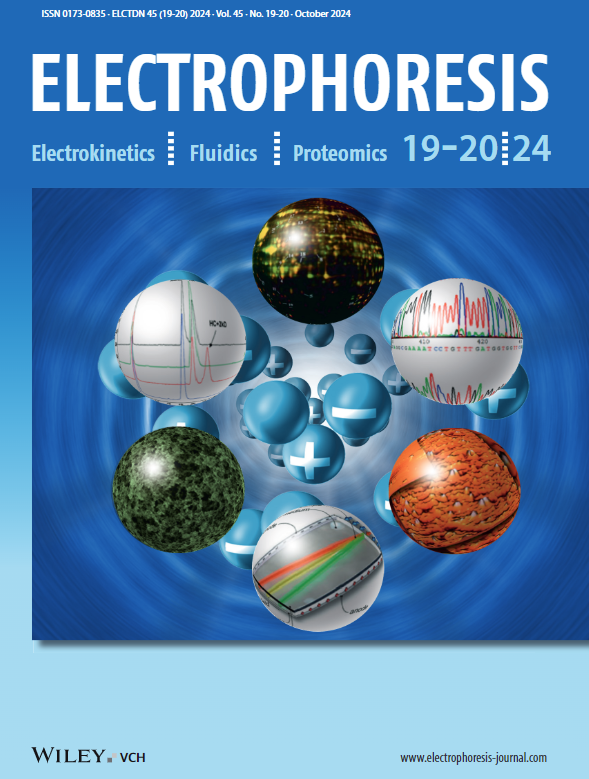Streaming electric field, electroviscous effect, and electrokinetic liquid flows in the induced pressure‐driven transport of active liquids in narrow capillaries
IF 3
3区 生物学
Q2 BIOCHEMICAL RESEARCH METHODS
引用次数: 0
Abstract
In this paper, we develop a theory for studying the electrokinetic effects in a charged nanocapillary filled with active liquid. The active particles present within the active liquid are self‐driven, demonstrate vortex defects, and enforce a circumferentially arranged polarization field. Under such circumstances, there is the development of an induced pressure‐gradient‐driven transport dictated (similar to diffusioosmotic transport) by the presence of an axial gradient in the activity (or the concentration of the active particles). This pressure‐driven transport has a profile different from the standard Hagen–Poiseuille flow in a nanocapillary. Also, this induced pressure‐driven flow drives electrokinetic effects, which are characterized by the generation of a streaming electric field, associated electroosmotic (EOS) transport opposing pressure‐driven flow, and electroviscous effect. We quantify these effects as functions of dimensionless parameters that vary inversely as the strength of the activity‐induced pressure‐driven flow and salt concentrations. Overall, we anticipate that this paper will draw immense attention toward a new type of activity‐induced pressure‐driven flow and associated electrokinetic phenomena in charged nanoconfinements.窄毛细管中活性液体的诱导压力驱动输送中的流动电场、电粘性效应和电动液体流
在本文中,我们提出了一种理论,用于研究充满活性液体的带电纳米毛细管中的电动效应。存在于活性液体中的活性粒子是自驱动的,表现出涡旋缺陷,并强制形成周向排列的极化场。在这种情况下,由于活性(或活性粒子浓度)轴向梯度的存在,会产生诱导压力梯度驱动传输(类似于扩散渗透传输)。这种压力驱动的传输与纳米毛细管中的标准哈根-普瓦耶流具有不同的轮廓。此外,这种诱导的压力驱动流还会驱动电动效应,其特点是产生流电场、与压力驱动流相反的相关电渗(EOS)传输以及电粘性效应。我们将这些效应量化为无量纲参数的函数,这些参数与活动诱导的压力驱动流的强度和盐浓度成反比变化。总之,我们预计这篇论文将引起人们对带电纳米材料中新型活动诱导压力驱动流和相关电动现象的极大关注。
本文章由计算机程序翻译,如有差异,请以英文原文为准。
求助全文
约1分钟内获得全文
求助全文
来源期刊

ELECTROPHORESIS
生物-分析化学
CiteScore
6.30
自引率
13.80%
发文量
244
审稿时长
1.9 months
期刊介绍:
ELECTROPHORESIS is an international journal that publishes original manuscripts on all aspects of electrophoresis, and liquid phase separations (e.g., HPLC, micro- and nano-LC, UHPLC, micro- and nano-fluidics, liquid-phase micro-extractions, etc.).
Topics include new or improved analytical and preparative methods, sample preparation, development of theory, and innovative applications of electrophoretic and liquid phase separations methods in the study of nucleic acids, proteins, carbohydrates natural products, pharmaceuticals, food analysis, environmental species and other compounds of importance to the life sciences.
Papers in the areas of microfluidics and proteomics, which are not limited to electrophoresis-based methods, will also be accepted for publication. Contributions focused on hyphenated and omics techniques are also of interest. Proteomics is within the scope, if related to its fundamentals and new technical approaches. Proteomics applications are only considered in particular cases.
Papers describing the application of standard electrophoretic methods will not be considered.
Papers on nanoanalysis intended for publication in ELECTROPHORESIS should focus on one or more of the following topics:
• Nanoscale electrokinetics and phenomena related to electric double layer and/or confinement in nano-sized geometry
• Single cell and subcellular analysis
• Nanosensors and ultrasensitive detection aspects (e.g., involving quantum dots, "nanoelectrodes" or nanospray MS)
• Nanoscale/nanopore DNA sequencing (next generation sequencing)
• Micro- and nanoscale sample preparation
• Nanoparticles and cells analyses by dielectrophoresis
• Separation-based analysis using nanoparticles, nanotubes and nanowires.
 求助内容:
求助内容: 应助结果提醒方式:
应助结果提醒方式:


